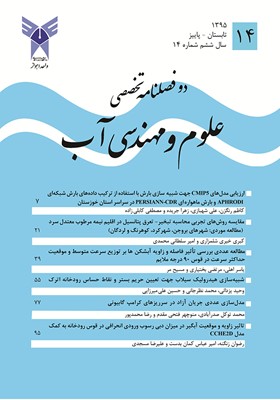Comparison of different empirical methods for estimating ddaily reference evapotranspiration in the humid cold climate (case study: Borujen, Shahrekord, Koohrang and Lordegan)
الموضوعات : Irrigation and Drainageکبری خیری شلمزاری 1 , امیر سلطان محمدی 2
1 - گروه آبیاری و زهکشی، دانشگاه شهید چمران، اهواز، اهواز، ایران.
2 - گروه آبیاری و زهکشی، دانشگاه شهید چمران، اهواز، ایران.
الکلمات المفتاحية: تبخیر- تعرق پتانسیل, Reference evapotranspiration, Empirical methods, Humid cold climate, Valiantzas, روشهای تجربی, اقلیم نیمه مرطوب و والیانتز,
ملخص المقالة :
The proposed method for calculation of potential evapotranspiration is Penman-Monteith FAO method, but there are other methods that require less meteorological data but estimates close to the FAO Penman-Monteith method in different climatic conditions. Performance evaluation of these methods on the same basis is prerequisite for selecting an alternative approach in accordance with available data. In this study, daily values of potential evapotranspiration in the period of 21 years (1994-2015) estimated using empirical methods ;Copais, Turc, Hargreaves-Samani, Hargreaves, Ritchie, Irmak and three forms of Valiantzas equation for Borujen, Shahrekord, Koohrang and Lordegan, located in humid cold climate region of Chaharmahal and Bakhtiary province and values were compared with Penman-Monteith FAO method. To compare the results, the root mean square error, error absolute value and coefficient of determination was used. The results show that the equations of Irmak and Valiantzas (RS, T,RH,U ) performs better than the other empirical methods in four stations and the Hargreaves method showed very poor estimation of evapotranspiration than FAO Penman-Monteith method with 92.25 percent relative error. Also, comparison of total potential evapotranspiration estimated with empirical methods determined that equation of Irmak and Valiantzas (Rs, T, RH, U) for all the stations were the most efficient way.
تفضلی، ف .(1385) .ارزیابی حساسیت مدلهای برآورد تبخیر و تعرق به تابش ورودی روزانه در شرایط اقلیمی همدان . پایان نامه کارشناسی ارشد گروه مهندسی آب، دانشکده کشاورزی، دانشگاه بوعلی سینا، همدان.
زارع ابیانه، ح.، بیاتورکشی، م.، سبزیپرور، ع.، معروفی، ص.، قاسمی، ع. (1389). ارزیابی روشهای مختلف برآورد تبخیر- تعرق گیاه مرجع و پهنهبندی آن در ایران. پژوهشهای جغرافیایی طبیعی، (74): 110-95.
سلطانی، ا.، میر لطیفی، س. م.، دهقانی سانیج، ح. (1391). برآورد تبخیر- تعرق کرجع با استفاده از دادههای محدود هواشناسی در شرایط اقلیمی مختلف. نشریه آب و خاک (علوم و صنایع کشاورزی)، 26 (1): 149-139.
موسوی بایگی، م.، اشرف، ب.، میان آبادی، آ. (1389). ارزیابی جهار مدل تبخیر- تعرق گیاه مرجع در یک اقلیم نیمه خشک ایران با هدف انتخاب بهترین مدل تابش. مجله پژوهشهای حفاظت آب و خاک، 17 (4) :105-87.
Allen, R. G., Pruitt, W. O. (1991). FAO-24 Reference evapotranspiration factors. Journal of Irrig. Drain. Eng., 117,5 , pp: 758-773.
Allen, R.G., Pereira, L.S., Raes, D., Smith, M. (1998). Crop evapotranspiration – guidelines for computing crop water requirements, FAO Irrigation and Drainage Paper 56, FAO, pp:19- 5.
Alexandris, S., Kerkides, P., Liakatas, A. (2006). Daily reference evapotranspiration estimates by the Copais approach. Agric. Water Manage., 82, pp: 371–386.
Djaman, k., Balde, A.,Sow, A., Muller, B., Irmak, S., N’Diaye, M., Manneh, B., D.Moukoumbi, Y., Futakuchi, K ., Saito, K. (2015). Evaluation of sixteen reference evapotranspiration methods under sahelian conditions in the Senegal River Valey.Journal if Hydrology: Regional Studies 3, pp:139-159
Hargreaves, G.H. 1975. Moisture availability and crop production, Trans. Am. Soc. Agric.Eng., 18, 5, pp: 980-984.
Hargreaves, G. H., Samani, Z. A. (1985). Reference crop evapotranspiration from temperature. Appl. Eng. Agric., 1, 2, pp: 96–99.
Irmak, S., Irmak, A., Allen, R.G., Jones, J. W. (2003). Solar and net radiation-based equations to estimate reference evapotranspiration in humid climates. Journal of Irrig. Drain. Eng., ASCE ,129, 5, pp: 336–347.
Jones, J. W., Ritchie, J.T. (1990). Crop growth models. Management of farm irrigation system, G.J. Hoffman, T.A. Howel, and K.H. Solomon, eds., ASAE Monograph No.9, ASAE, St. Joseph, Mich. pp: 63-89.
Kisi, O. (2013). Comparison of different empirical methods for estimating daily reference evapotranspiration in Mediterranean climate. Journal of Irrigation and Drainage Engineering, 140,1 pp: 1-24.
Pandey, P., P.Dabral, P., Pandey, V.(2016). Evaluation of reference evapotranspiration methods for the northeastern region of India. International Soil and Water Conservation Research 4. pp: 52-63.
Valipour, m. (2015). Investigation of Valiantzas’ evapotranspiration equation in Iran. Theoretical and Applied Climatology, 121, 1-2, pp: 267-278.
Valiantzas, J. (2013). Simplified forms for the standardized FAO-56 Penman- Monteith refrence evapotranspiration using limited wether data. Journal of Hydro., 505, pp: 13-23.
Valiantzas, J. (2015). Simplified limited data Penman 15ET0"> formulas adapted for humid Locations. Journal of Hydro, pp: 701-707.


